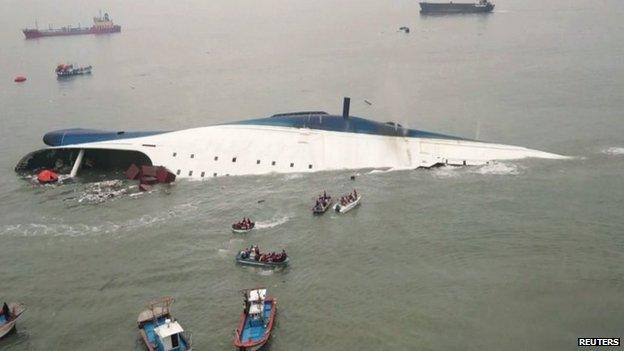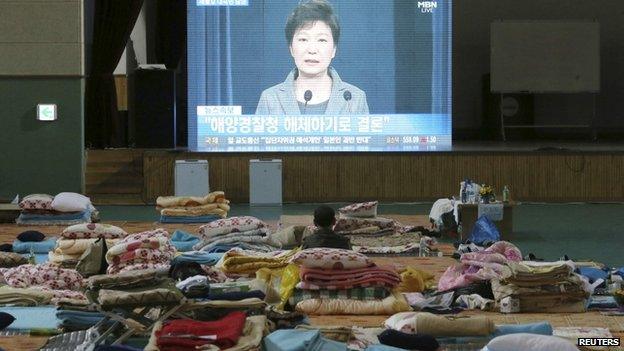South Korea to break up coastguard after ferry disaster
- Published

Only 172 people escaped from the Sewol as it sank on 16 April
South Korea plans to break up its coastguard in the wake of the ferry disaster in which more than 300 people died, says President Park Geun-hye.
In a televised address, Ms Park apologised formally for the sinking.
A new safety agency would handle rescue duties, with investigative functions passing to the police, she said.
The Sewol ferry disaster on 16 April killed 286 passengers, most of whom were high school students. Another 18 are still missing.
"The ultimate responsibility of the poor response to this accident lies with me," Ms Park said.
She said the coastguard had "failed to fulfil its original duties" and "had it actively carried out rescue efforts immediately after the accident", more lives could have been saved.
Ms Park added that in its current form, the coastguard would be unable to prevent another large-scale disaster.
"The coastguard continued to get bigger in size but did not have enough personnel and budget allocated for maritime safety, and training for rescue was very much insufficient," she said, according to Reuters.
Ms Park's office told agencies that her plans had to be approved by the National Assembly, in which her Saenuri party maintains a majority.
A tearful Ms Park said the "final responsibility" for the tragedy, lay with her.

Her speech was broadcast live at a Jindo gymnasium where relatives of missing passengers are staying
'Abnormal practice'
The planned disbanding of the coastguard is one of several reforms the South Korean leader announced on Monday.
An interim investigation found that the ferry was overloaded, carrying three times its approved amount of cargo, and that a sharp turn destabilised it and caused it to capsize.
Officials from the ferry's operator and a company that conducted safety checks on the vessel prior to the incident have also been arrested.
"A 20-year-old vessel was bought and refurbished to add excessive capacity, then it was loaded with much more cargo than allowed with a false reporting on weight, but not a single person in the position to supervise stopped any of it," Ms Park said.
She said she planned to increase restrictions on government officials taking up jobs related to their duties after retirement. The practice, also known as "bureaucratic mafia" in South Korea, is seen as fostering too-cosy ties between bureaucrats and regulators.
The accident showed "how big a calamity can be brought about by the abnormal practice of collusion between the government and civilians", she was quoted as saying by Yonhap news agency.
The president also proposed establishing a committee to look into whether the Sewol ferry accident was caused by corruption and other irregularities.
Ms Park's administration has been the subject of continued criticism over the accident, particularly on the speed of search and rescue operations, despite earlier apologies from her and the resignation of Prime Minister Chung Hong-won.
Only 172 passengers survived the sinking of the ferry, including 22 of the 29 crew members.
The ferry captain and three members of the crew have been charged with manslaughter. Prosecutors have indicted another 11 crew members for negligence, for failing to evacuate passengers.
